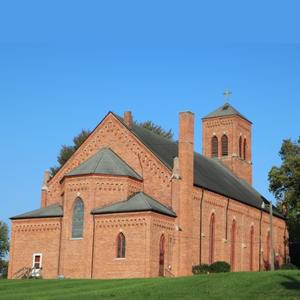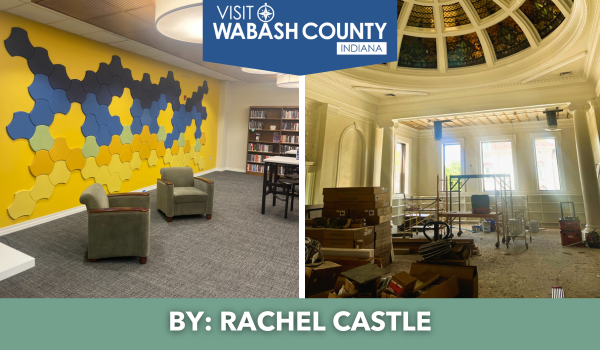Canal Played Major Factor in Developing Wabash County
By: Joseph Slacian
The Wabash and Erie Canal, though short-lived, played a great role in helping develop Wabash and much of Indiana in the early 19th century. The U.S. Congress provided a land grant to the State of Indiana to create the canal. Work on the canal began in Fort Wayne in 1832 and was finished in Evansville in 1853. By 1870, the railroad made its mark and four years later the canal system was abandoned totally. However, today there are still traces of it that can be found in Wabash County.

Surveyed in 1818, the canal was one of the major reasons that Indiana became a state. To obtain the land for the canal, the 1826 Treaty of Paradise Spring was signed. Today, the ground at which the treaty was signed is the Paradise Spring Historical Park, located at the intersection of Market and Allen streets. The park includes walkways and a trail that leads along the Wabash River, which was the main route during the canal days.
Early on, it wasn’t sure if the canal would indeed pass through Wabash County. Officials from Ohio wanted the canal to run south of Cincinnati. A compromise was reached, and the ground on the canal was broken on February 22, 1832, in Fort Wayne. A six-mile stretch of the canal was finished by June 1834 and later that year, contracts for a stretch in Wabash County were let. By July 4, 1835, the canal stretched from Fort Wayne to Huntington, connecting the Maumee and Wabash rivers.
It was either on July 4, 1836, or July 4, 1837, various histories are conflicting on the exact day, that the canal boat Indiana, captained by Dana Columbia, was the first to reach Wabash. It was followed shortly later by the Prairie Hen.
The canal reached Peru in 1837 and either that year or in 1838 — again, historical reports conflict — reached Logansport. It was in Logansport where a turning basin was constructed, allowing the canal boats to turn around and continue back the way they came. An aqueduct across the Eel River was constructed in 1840, and the canal reached past Lafayette by 1847. Twenty-one years after the first shovel for the canal was turned in Fort Wayne, it reached its final destination in Evansville. According to legend, the year the canal reached Evansville, the railroad — which quickly marked the canal system’s demise — reached that city as well.
There is a record of three locks having been built in Wabash County. One is located between Wabash and Richvalley, near the Norfolk and Southern underpass on old U.S. 24. The second, the Kerr Lock, is in Lagro and is still visible today. A third, located in Wabash, vanished in the 1940s when it was filled in.
The lock system was important to the canals. A boat captain signaled the lock tender that the vessel was approaching by blowing either a tin or brass horn. The lock gates were controlled by 10-inch timbers that were 20 feet long. The gates were opened by hand, and from time to time boat passengers and crew members needed to help push against an 11 foot head of water at the gates.
The locks were wide enough for one boat to pass through at a time. Eastbound boats had the right-of-way, as they were traveling with the current. When two boats met along the canal, the westbound boat would stop and the horse or mule team would move to the outside of the towpath, causing the boat to drift to the opposite side of the canal until the tow line sank and set anchor. The eastbound team, using the inside of the towpath, stepped over the loose rope, pulled the boat over the submerged line and the westbound boat then continued its journey. The canal’s towpath was 10 feet wide, and the path varied on which side it was on, depending on the terrain alongside the river.
Ironically, the canal system helped bring about its own demise. In 1854, just one year after the canal reached Evansville, four boatloads of iron arrived in Wabash, iron which was used in creating the railroad system here. In 1856, the first passenger train arrived.

While the canal system continued for another 20 years, the impending doom could be easily seen. Railroads were a faster mode of transportation. By 1861, the railroad had reported earning more than $31,000 in one week, nearly $10,000 per week more than one year earlier. The use of the railroad continued to increase, just as the use of the canal continued to decrease.
According to records, the canal transported, among other things, 91,711 barrels of flour, and 882,765 bushels of wheat in 1847. By 1859, the amount of flour carried on canal boats dropped to 28,680 barrels while the amount of wheat dropped to 14,805 bushels.
Although the canal was a failure, the fact that the canal did travel through Wabash made it a center for industry and trade. And in the years after it left, the canal was still serving the community, as the former towpaths were used as the right-of-way for the interurban street car system that served Wabash for many years.
In addition to the Kerr Locks in Lagro and the remnants of the locks near Richvalley, there is little evidence of the canal system in Wabash visible today. The rear doors on the buildings on the south side of Canal Street offer some of the evidence, as they were built there to face the canal docks which ran directly behind them.

Likewise, St. Patrick’s Catholic Church, built for the Irish laborers who helped dig the canal, still stands. Though no longer an actual church, Mass is said at the site one Sunday per month.



